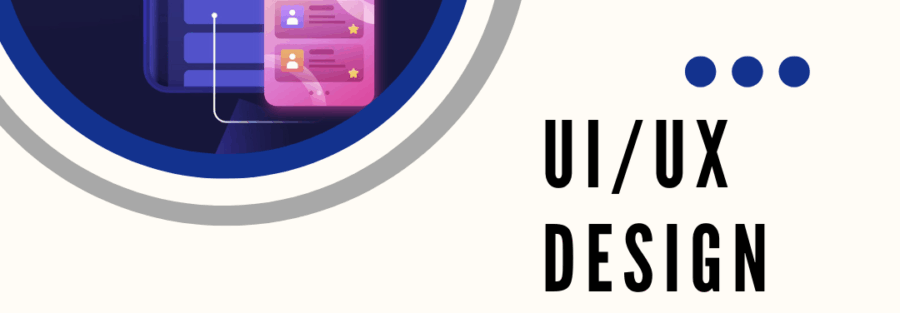Introduction to UI/UX Design:
In today’s digital landscape, creating seamless and user-friendly experiences is more important than ever. This is where UI (User Interface) and UX (User Experience) design come into play. These two disciplines work together to enhance how users interact with websites, mobile apps, and digital products. A well-designed interface (UI) ensures a visually appealing and easy-to-use platform, while a thoughtful user experience (UX) focuses on functionality, usability, and efficiency. Cloud Vision Technologies.
UI/UX design is not just about aesthetics; it is about solving user problems through intuitive and interactive designs. Whether it’s a simple mobile app or a complex web platform, UI/UX plays a crucial role in ensuring that users can navigate, engage, and achieve their goals effortlessly. As businesses compete in the digital space, having an effective UI/UX design has become essential for retaining users, increasing conversions, and building a strong brand identity. UI/UX Design Classes.

What is UI Design?
UI design refers to the visual elements and interactive features of a digital product that users engage with directly. It involves crafting interfaces that are visually appealing, easy to navigate, and functionally effective. UI design includes elements such as buttons, typography, icons, color schemes, images, and layout arrangements.
The primary goal of UI design is to ensure the interface is aesthetically pleasing and user-friendly. By aligning design elements with the brand’s identity and user preferences, UI designers create interfaces that resonate with the target audience. Tools like Adobe XD, Figma, and Sketch are widely used in the UI design process. UI/UX Design Classes.
What is UX Design?
UX design, on the other hand, focuses on the overall experience a user has when interacting with a digital product. It encompasses all aspects of the user journey, including ease of use, accessibility, and emotional engagement. UX design is about solving problems, meeting user needs, and ensuring satisfaction throughout the interaction.
UX designers often rely on research and data to understand user behavior, preferences, and pain points. They use this information to create wireframes, prototypes, and workflows that guide the development of the final product. The ultimate aim is to make the user’s interaction as efficient, enjoyable, and meaningful as possible. UI/UX Design Classes.
Difference Between UI and UX Design:
In an era dominated by technology, businesses prioritize UI/UX design to deliver exceptional products that not only meet user expectations but also stand out in competitive markets. This blog explores the fundamentals, principles, and benefits of UI/UX design, providing a comprehensive understanding of its significance in the digital world. While UI and UX design are closely related, they serve distinct purposes:
UI Design focuses on how a product looks and feels. It involves designing the graphical layout and ensuring it is visually appealing. UI/UX Design Classes.
UX Design focuses on how a product works and how users interact with it. It involves optimizing usability and ensuring the experience aligns with user expectations.
Together, UI and UX design work in harmony to deliver a cohesive product. While UI design grabs the user’s attention with its aesthetics, UX design ensures the product meets the user’s needs and provides value. UI/UX Design Classes.
Key Principles of UI Design
Consistency: Consistency in fonts, colors, icons, and layout ensures a seamless experience across the product. It helps users navigate the interface effortlessly.
Clarity: A clear and straightforward design reduces confusion and enhances usability. Each element should have a purpose and be easy to understand. UI/UX Design Classes.
Accessibility: The design should be inclusive, catering to users with disabilities by incorporating features like adjustable font sizes, screen readers, and keyboard navigation.
Feedback: Providing feedback, such as hover effects or success messages, keeps users informed about their actions and the system’s response. UI/UX Design Classes.
Visual Hierarchy: Organizing content in a way that highlights the most important elements first helps guide the user’s focus and improves navigation. UI/UX Design Classes.

Key Principles of UX Design
User-Centered Design: The design should revolve around the user’s needs, goals, and preferences. User research is essential to understand the target audience.
Simplicity: A simple and intuitive design ensures users can achieve their goals without unnecessary complications. UI/UX Design Classes.
Usability Testing: Regular testing with real users helps identify issues and improve the product’s functionality. UI/UX Design Classes.
Emotional Design: Creating a design that resonates emotionally with users UI/UX Design Classes.UI/UX Design Training Institute in Hyderabad.
Adaptability: The product should perform seamlessly across different devices and platforms, ensuring a consistent experience.
Why UI/UX Design Matters?
Enhanced User Engagement
A well-structured UI/UX design captures user interest and encourages them to spend more time on the platform. Interactive elements, smooth animations, and visually appealing layouts keep users engaged, making their experience enjoyable. When users find an interface easy to navigate and visually stimulating, they are more likely to return, increasing overall retention rates and brand loyalty. UI/UX Design Classes.
Improved Usability
A user-friendly interface simplifies navigation, helping users find what they need quickly and efficiently. Clutter-free layouts, intuitive menus, and responsive designs contribute to a seamless experience, reducing frustration. When users can interact with a product effortlessly, they are more likely to complete their intended actions, whether it’s making a purchase, signing up for a service, or consuming content. UI/UX Design Classes.
Higher Conversion Rates
Businesses that invest in effective UI/UX design often experience increased conversion rates. Whether it’s an e-commerce store, a mobile app, or a SaaS platform, a well-optimized design guides users through a smooth journey, minimizing friction in the sales or subscription process. Call-to-action buttons, clear navigation, and persuasive design elements encourage users to take the desired action, boosting revenue and customer retention. UI/UX Design Classes.
Brand Reputation
A seamless and aesthetically pleasing UI/UX design builds trust and credibility. Users associate a well-designed interface with professionalism and reliability, which strengthens a brand’s image. Poor UI/UX, on the other hand, can lead to frustration and drive users away, negatively impacting the brand’s reputation. A positive user experience creates loyal customers who are more likely to recommend the product to others. UI/UX Design Classes.
Competitive Advantage
In an overcrowded digital marketplace, a superior UI/UX design helps a product stand out. Businesses that prioritize user-centered design gain an edge over competitors by offering a more intuitive and enjoyable experience. A visually compelling and functional design can attract new users, retain existing customers, and position a brand as a leader in its industry.
Tools Used in UI/UX Design:
The UI/UX design process involves a wide range of tools that help designers conceptualize, prototype, test, and collaborate effectively. These tools streamline the workflow and ensure that the final product meets both user needs and business goals. Here’s an expanded look at the categories of tools used in UI/UX design:
UI Design Tools
UI design tools are essential for creating visually appealing and interactive user interfaces. These tools allow designers to craft layouts, design components, and ensure the visual consistency of digital products. UI/UX Design Classes.
Adobe XD: Adobe XD is a powerful tool for designing and prototyping interfaces. It offers features like repeat grids, responsive resizing, and integration with other Adobe Creative Cloud tools, making it a favorite among UI designers.
Figma: Figma is a cloud-based design tool that allows real-time collaboration among team members. It’s widely appreciated for its intuitive interface, powerful vector editing tools, and the ability to create shared libraries of design components.
Sketch: Sketch is a macOS-based design tool known for its simplicity and efficiency. It is ideal for creating high-quality UI designs, with features like symbol libraries, vector editing, and seamless integration with prototyping tools. UI/UX Design Classes.
InVision: InVision combines design, prototyping, and collaboration in one platform. Designers can create interactive prototypes, receive feedback, and collaborate with stakeholders directly within the tool.UI/UX Design Classes.d.
UX Research Tools
UX research tools help designers gather insights into user behavior, preferences, and pain points. These insights are crucial for creating user-centric designs.
UserTesting: UserTesting is a platform that enables designers to observe real users interacting with their product. It provides valuable feedback through video recordings, surveys, and usability testing. UI/UX Design Classes.
Hotjar: Hotjar is a popular tool for analyzing user behavior through heatmaps, session recordings, and feedback polls. It helps identify areas of improvement by showing how users navigate and interact with the interface. UI/UX Design Classes.
Google Analytics: Google Analytics provides in-depth data on user behavior, including metrics like bounce rate, session duration, and conversion paths. It helps designers understand user journeys and identify areas for optimization.

Key Elements of UI/UX Design:
User Research
User research is the foundation of effective UI/UX design. It involves gathering insights about the target audience, including their behaviors, preferences, pain points, and expectations. Techniques such as surveys, interviews, usability testing, and analytics help designers understand user needs and create solutions that enhance their experience. Without proper research, even a visually stunning design can fail to meet user expectations.
Wireframing & Prototyping
Wireframing is the process of creating basic sketches or blueprints of a product’s layout, helping designers map out key features and content placement. Prototyping takes this a step further by creating interactive models that simulate user interactions. These steps allow designers to test functionality, receive feedback, and refine the design before moving to the development stage. This iterative process helps in minimizing errors and optimizing the overall user experience. UI/UX Design Classes.
Visual Design
Visual design focuses on aesthetics and branding, ensuring that the interface is visually appealing while maintaining usability. This includes the selection of colors, typography, icons, and images that align with the brand identity and enhance readability. A well-crafted visual design not only attracts users but also provides a consistent and cohesive experience across different devices and platforms.
Interaction Design
Interaction design ensures that users can navigate through the digital product effortlessly. This includes designing smooth transitions, hover effects, animations, and micro-interactions that make the experience engaging and intuitive. Well-thought-out interaction design helps in reducing friction, making the interface more responsive and enjoyable for users.
Usability Testing
Usability testing is the process of evaluating a product by testing it with real users. It helps identify issues, bottlenecks, and areas of improvement in the design. Conducting usability tests at different stages of development allows designers to make necessary adjustments, ensuring a polished final product. This step is crucial in creating an intuitive and user-friendly interface that meets user expectations. UI/UX Design Classes.
UI/UX Design Trends in 2024:
Dark Mode Interfaces
Dark mode has gained significant popularity as it enhances readability in low-light environments, reduces eye strain, and saves battery life on OLED and AMOLED screens. Many apps and websites now offer dark mode as an optional feature, allowing users to switch between light and dark themes based on their preference. Brands are also using dark-themed designs to create a sleek, modern aesthetic that appeals to users.
Minimalist Design
The trend of minimalism in UI/UX design focuses on simplifying interfaces by eliminating unnecessary elements, using ample white space, and adopting clean typography. This approach enhances clarity, improves user focus, and creates a distraction-free experience. By prioritizing essential content and interactions, minimalist design helps users achieve their goals effortlessly without overwhelming them with information. UI/UX Design Classes.
Micro-Interactions
Micro-interactions are small, subtle animations and feedback mechanisms that improve user engagement. These can be as simple as a button changing color when clicked, a loading animation, or a success notification. Micro-interactions enhance usability by providing instant feedback to users, making the interface feel more interactive and responsive. They create a more delightful experience and keep users engaged with the product.
AI-Powered Personalization
Artificial intelligence (AI) is revolutionizing UI/UX design by enabling personalized user experiences. AI analyzes user behavior, preferences, and past interactions to tailor content, recommendations, and interface adjustments. For example, streaming platforms suggest content based on viewing history, and e-commerce sites provide personalized product recommendations. AI-driven personalization enhances user satisfaction and increases engagement. UI/UX Design Classes.
Voice UI & Gesture-Based Navigation
With the rise of smart assistants like Alexa, Siri, and Google Assistant, voice user interfaces (VUI) are becoming more prominent. Users are increasingly relying on voice commands to navigate digital products, search for information, and control smart devices. Similarly, gesture-based navigation, such as swipe gestures on mobile devices, is making interactions more intuitive and efficient. These advancements are reshaping how users interact with digital platforms beyond traditional touch interfaces. UI/UX Design Classes.
Importance of UI/UX Design
The significance of UI/UX design cannot be overstated in today’s digital-first world. It goes beyond aesthetics to ensure that products provide a functional, enjoyable, and seamless experience for users. Here’s a deeper dive into the key benefits of UI/UX design:
Improved User Satisfaction
A well-designed interface combined with a seamless user experience creates a product that feels intuitive and delightful to use. When users can navigate easily, achieve their goals quickly, and enjoy the process, their satisfaction skyrockets. Positive experiences also lead to higher levels of trust and loyalty, making users more likely to recommend the product to others. UI/UX Design Classes.
In today’s digital era, user experience (UX) and user interface (UI) design play a crucial role in shaping how people interact with websites, applications, and digital products. A well-designed UI ensures a visually appealing and intuitive interface, while UX focuses on optimizing usability and functionality to enhance user satisfaction. Together, these design principles create seamless and enjoyable experiences that can make or break the success of a digital product. UI/UX Design Classes.
Increased Retention
A product that delivers a smooth and enjoyable experience naturally encourages users to return. By minimizing frustrations and meeting expectations, good UI/UX design fosters long-term relationships with users. Whether it’s an app, website, or software, repeat usage often depends on how comfortable and intuitive the experience is.
Brand Credibility
The design of a product directly impacts how users perceive the brand. A clean, professional, and visually appealing design builds trust and reflects the brand’s reliability and attention to detail. Conversely, a poorly designed interface can erode trust, no matter how good the underlying functionality might be. UI/UX Design Classes.
Competitive Advantage
In a crowded market, exceptional UI/UX design can be the defining factor that sets a product apart from its competitors. With users having access to multiple alternatives, a product with an intuitive interface and superior user experience is more likely to stand out and succeed
Higher Conversion Rates
UI/UX design plays a critical role in guiding users through their journey, whether it’s signing up for a service, making a purchase, or completing a task. By understanding user behavior and designing pathways that minimize friction, businesses can significantly boost conversions and sales.UI/UX Design Classes.

UI/UX Design Classes:
UI (User Interface) design refers to the visual elements and interactive features of a digital product. It includes typography, color schemes, button designs, and navigation structures that ensure a smooth interaction for users. UX (User Experience) design, on the other hand, focuses on the overall journey of the user, aiming to provide meaningful and efficient interactions. It involves user research, wireframing, prototyping, and usability testing to refine the design based on user feedback. UI/UX Design Classes.
Conclusion
UI/UX design is essential for delivering a seamless and satisfying digital experience. Whether for websites, apps, or software products, a well-executed design ensures user satisfaction, drives conversions, and strengthens brand loyalty. As technology evolves, staying updated with UI/UX trends and best practices will help businesses create intuitive and engaging digital experiences for their users. UI/UX Design Classes.
UI/UX design is a critical component of digital product development, bridging the gap between user expectations and business objectives. By focusing on aesthetics, functionality, and user satisfaction, UI/UX designers play a pivotal role in shaping the success of a product. Whether you’re a business owner, developer, or aspiring designer, understanding the principles and importance of UI/UX design is essential in today’s digital landscape. Investing in quality UI/UX design not only improves user engagement but also establishes a brand as a leader in innovation and customer satisfaction UI/UX Design Classes.
Address: Cloud Vision Technologies
Location: Samhitha Enclave, 3rd floor, KPHB Phase 9, Kukatpally, Hyderabad, Telangana – 500072
Contact Number : +91 8520002606
Mail ID: info@cloudvisiontechnologies.com
Website: https://cloudvisiontechnologies.com




